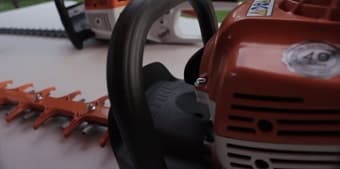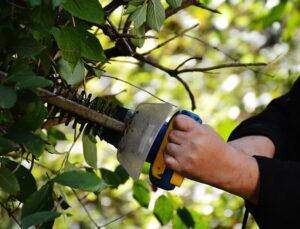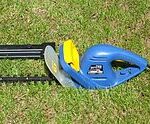As an Amazon Associate, this site earns commissions from qualifying purchases. For more information click here.
Brambles grow very quickly and if not managed right, will spread all over your garden and take over large areas. One question that is often asked is if you can use a hedge trimmer to remove them. Hedge trimmers are often used on hedges and shrubs, but will it work on brambles? Or are you better off using another cutting tool?
It is difficult to cut brambles with a hedge trimmer because the stem often gets entangled with the blade. But if you have a powerful trimmer it is possible to cut brambles and its branches.
To make it clear, the best tool to get rid of brambles is a brush cutter. But if you do not have one you can use a hedge trimmer. In spite of what you might have heard, a hedge trimmer can do the job. It takes a bit more effort but it does work.
What Hedge Trimmer to Use on Brambles?
It depends on the brambles you want to cut. Some brambles can reach heights of over six feet and can be very thick. Most hedge trimmers can only cut branches up to 3/4 of an inch thick. There are some trimmers that can cut thick branches now available however. The Hyperecho 40V Cordless Trimmer has a 1 inch cutting capacity for one.
If you are not sure what hedge trimmer to buy, here are some suggestions.
- If the brambles are very tall, tangled and thick, use a brush cutter to cut the largest parts. You can then use a hedge trimmer to clear up the rest. If you do not have a brush cutter, pruning shears will do.
- Gas hedge trimmers are the most powerful type of trimmers and work well on brambles. Corded trimmers are not as powerful and you are limited by the cord length. There are also cordless units but most do not have the power needed to remove brambles.
- If you want to use a hedge trimmer to cut brambles, you have to cut regularly. Do not wait for the branches to grow and thicken, as it will make the job harder.
How to Cut Brambles with a Hedge Trimmer
Before attempting to cut brambles, conduct a maintenance check. If your hedge trimmer won’t stay running for instance, you have to fix that first. Brambles require a lot out of trimmers so yours must be in good condition.
Step 1: Prepare the Trimmer
Add oil to the engine. Most hedge trimmers are 2-stroke so you have to mix gas and oil at a 40:1 or 50:1 ratio. Check your user manual for the mix recommendation.
Step 2: Wear Safety Gear
Wear gloves to protect your hands from accidental cuts or scrapes. Put on safety goggles to shield your eyes from branches, leaves and other debris. Once you start trimming all sorts of materials will start flying around you.
You have to put on a long sleeved shirt and pants. Cover every bit of exposed skin to avoid accidental cuts. The gloves and the rest of your clothing should be comfortable but also durable. Brambles have thorns and you do not want those to rip into your clothing.
Step 3: Start Cutting
Turn on the hedge trimmer and start cutting. Hold the tool as you normally would when trimming hedges and bushes.
If the brambles are tall, just let the blade do the work for you. Unlike a hedge, you do not have to worry about the cutting angle or shape. You just have to make sure the blade does not get entangled in any of the thicker branches.
It is a good idea to have pruning shears nearby to cut away thick branches. Take breaks especially if it is hot.
Your goal is to cut the brambles until it is only about 6 inches high. Depending on how tall the brambles are, this job can take a few minutes or a few days.
As the brambles get shorter, sit on a low chair so you can cut comfortably. Eventually you have to bend over or go down on one knee to finish cutting.
When you are done, turn the hedge trimmer off. Remove any branches or leaves stuck on the blades. Clean the tool and put it back in storage.
Step 4: Remove the Cut Brambles
Use a rake or similar tool to gather the brambles you cut and put them in the thrash. Make certain you collect all the debris including the berries, as any leftovers can grow again. We like the Lilyvan Garden Rake for its simplicity and efficiency.
The best way to dispose of brambles is to take them to a waste facility treatment. The other alternative is to burn them, but some cities do not allow this. Talk to the local authorities first. If burning brambles is not allowed, ask where the nearest plant waste facility is.
By the way, you cannot use brambles as compost material for plants. They do not provide any sustenance.
Step 5: Kill the Roots
Cutting off brambles with a hedge trimmer is only part of the job. The next step is to make sure that these brambles do not grow again.
To prevent brambles from growing again, you have to kill the roots. After you have cut the brambles down to 6 inches, apply weed killer. There are a lot of products available but the best are those with glyphosate or triclopyr.
Apply the weed killer on the roots and pour enough so the solution goes deep into the ground. When you apply triclopyr, you will not be able to plant there for many weeks, though it will not harm other plants. With glyphosate all the plants will perish, but you can plant soon after.
Apply the weed killer according to the product instructions. Wait 1-3 weeks for the full effect. During this period you will see any remaining brambles turn brown, wither and die. If nothing happens after three weeks, apply more of the weed killer.
Step 6: Uproot Remaining Roots
This step is optional, but if you want to make sure that the roots are gone, dig the spot where you used the weed killer. A small shovel ought to be enough. Uproot the roots and discard them. Actually you can do this if you do not want to use a weed killer. However it does take more time.
If you have a large garden, manually pulling bramble roots is not only tedious but can be physically exhausting. A better approach is to use a weed killer and dig up a few spots to see if there are any roots left.

How to Prevent Brambles from Growing Again
Killing or uprooting is a good way to prevent brambles from coming back. But if you want to keep other weeds from growing and spreading, you have to take certain steps.
Get rid of new growths right away. The best way to deal with brambles and similar growth is to remove them right away. If the growth is small enough you can use an electric hedge rammer.
Perform a thorough inspection of you garden every 1-2 weeks. If you see any roots, pull them out or use at trimmer to cut the branches off. The key is to do this as soon as possible to prevent the brambles from spreading. Do not wait until the brambles have become too large for the trimmer.
Take the same approach to any vines that creep up your walls. Use your hedge trimmer to cut them, and it is best to do this as soon as possible.
Keep your hedge trimmer in good condition. Your trimmer will perform its job if it is taken care of. After each use, remove any debris on the blade. You should also check if any dirt or clippings have gotten into the engine.
At least once a week, clan the air filter. Wash it in soapy water. If you are using a gas hedge trimmer, inspect the fuel filter, spark plug, fuel line, carburetor and other parts. Clean or replace them if required.

I love the outdoors and all the tools for maintaining gardens, yards and lawns. The only thing I am more passionate about is sharing what I know about garden and outdoor equipment.


